RA Bone Mineral Density Predicts Mortality
RA bone mineral density may be another indicator of the mostly hidden disease activity of rheumatoid disease (RD). Investigators studying patients in Texas have made some landmark observations.
RA bone mineral density may be associated with mortality
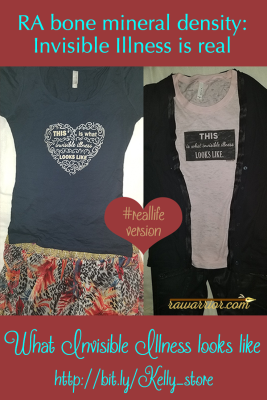 A session at the most recent scientific meeting of the American College of Rheumatology explored how RA bone mineral density is related to increased mortality in people with the disease. The session, “Low Appendicular Bone Mass Predicts Mortality in Patients with Rheumatoid Arthritis,” reviewed reduced lifespan in rheumatoid disease, most often due to cardiovascular causes. The authors suggested a meaningful association exists between osteoporosis and increased atherosclerosis of rheumatoid disease.
A session at the most recent scientific meeting of the American College of Rheumatology explored how RA bone mineral density is related to increased mortality in people with the disease. The session, “Low Appendicular Bone Mass Predicts Mortality in Patients with Rheumatoid Arthritis,” reviewed reduced lifespan in rheumatoid disease, most often due to cardiovascular causes. The authors suggested a meaningful association exists between osteoporosis and increased atherosclerosis of rheumatoid disease.
You might also like to read:
- Can Bones Hurt? Bone Pain and Rheumatoid Disease
- Nuclear Bone Scans for Rheumatoid Arthritis or Scintigraphy
Simple summary: RA bone mineral density as a significant indicator
The investigators studied 653 consecutive rheumatoid patients in San Antonio, Texas area, with average age 58, 72% of them women. They used “digital x-ray Radiogrammetry” (DXR) technology to calculate bone mineral density with digitized hand x-rays. DXR provides a “metacarpal index” (MCI) by a ratio of total bone width to cortical thickness. This MCI score quantifies peri-articular bone loss (bone loss near joints). DXR is more sensitive in detecting early RA bone mineral density loss than the DEXA (what is usually used, if bone mineral density is measured).
Then, they conducted a thorough investigation to learn of how many of the patients with rheumatoid disease (PRD) in the cohort had died.
Key points: Associations with RA bone mineral density (BMD)
1) Low BMD is independently associated with increased mortality in PRD*
2) Low DXR strongly associates with higher rheumatoid disease activity
3) Low DXR associates with significant joint destruction and may predict future joint destruction
4) The investigators concluded that BMD via DXR would be important to measure in rheumatology clinics.
5) Further research is needed to understand RA bone mineral density and mortality.
Bottom line: RA bone mineral density is part of a systemic disease
How can bone density be connected to mortality and heart disease in a “type of arthritis”? It can’t be.
Rheumatoid disease (RD) is obviously not a type of arthritis, but a systemic disease that affects all of the body. The same wasting disease that is destroying joint and bone tissue is wreaking havoc in other body organs and systems. Unfortunately, this is why RD increases mortality. Some aspect of the disease is responsible for both cardiovascular disease and lowered BMD.
Low RD / RA bone mineral density is independently related to RD mortality. #rheum Click To TweetIt’s reading thousands of studies like this one over the past 12 years that finally led me to publish a book to try to open eyes—and save lives. The connections between the systemic aspects of RD and the better-known joint symptoms are not in my imagination. Investigators are exploring their significance. And sometimes they suggest ways to mitigate risks for people—in this case measuring RA bone mineral density.
Living with a “bone eating” invisible illness
I know what it feels like to have most of your illness to be invisible. To have people assume you’re fine—even when you try to explain how the disease affects you. Low bone mineral density is one more invisible aspect of a cruel destructive disease. Honestly I so much wished for a t-shirt that said THIS is what invisible illness looks like that I designed some. And then I bought a few. And I’ve been wearing them often.
WHAT’S YOUR EXPERIENCE WITH INVISIBLE ILLNESS SYMPTOMS? HAVE YOU MEASURED RA BONE MINERAL DENSITY?
Recommended reading
- Ultrasound for Seeing Invisible Inflammation in Rheumatoid Patients
- 5 RA Facts Everyone Needs to Know
- What Causes Rheumatoid Arthritis Pain?
Click to read the online summary of this ACR session, “Low Appendicular Bone Mass Predicts Mortality in Patients with Rheumatoid Arthritis.”
* Low BMD is independently associated because other factors were adjusted for including age, sex, ethnicity, cardiovascular risk factors, measures of RA disease in joints, and joint damage.

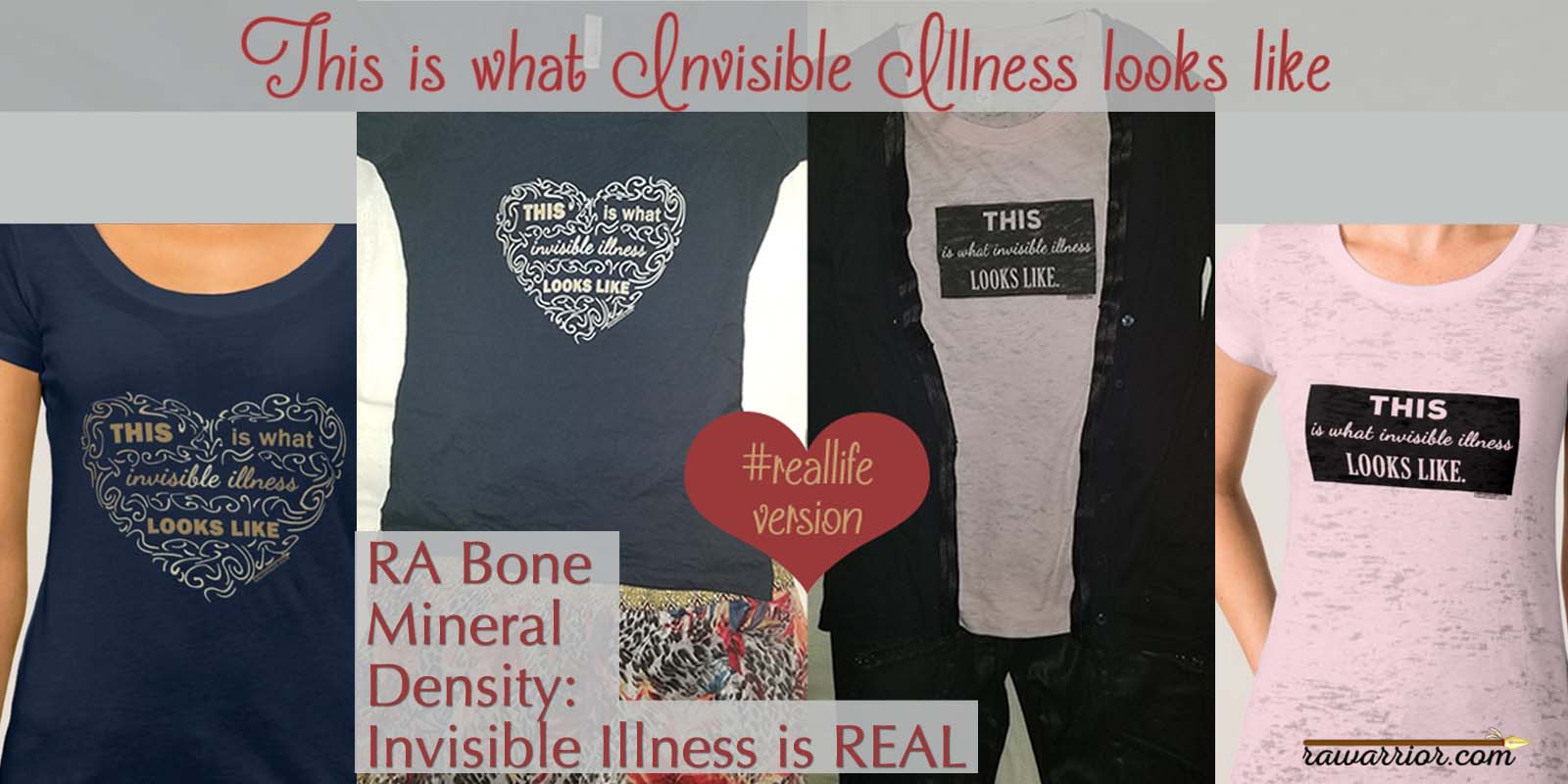

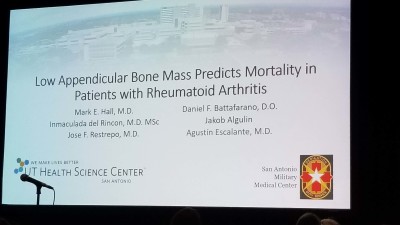
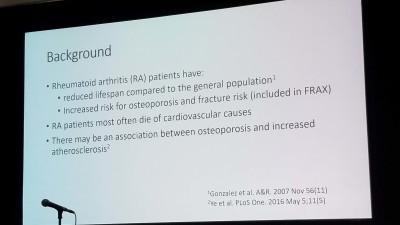
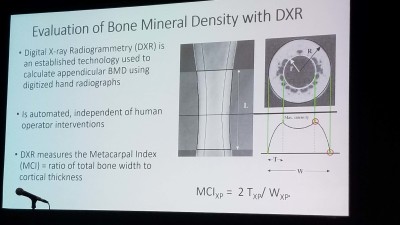


Hi Kelly,
This article is one more piece to the puzzle of RD. It is not only a connective tissue disease but a whole body systemic disease affecting everything in the body. Like dominos falling when one is tipped against a lined up pattern, this disease triggers widespread inflamation in one part only to move on to another. The information you give is so very important to understanding RD. One day all RD patients will be treated “whole body” because of your efforts to inform. I have been on Methotrexate for a month now and still waiting for improvement. I have Seronegative RD and have a Rheumatoid Nodule on my right hand knuckle. Had it before treatment so I know it’s not the medication. I understood only Seropositive formed nodules. Just shows how unpredictable and strange this disease can be. Again, thanks for all your efforts to bring about more understanding and pushing for more research for RD. The need is ever present for all of us struggling with RD.
Happy Christmas and blessings of the season to you and your family.
Cathy
Very interesting information. I just had my bone density tested, and it came up as early osteoporosis, at 44 years old. I have significant cardiovascular and pulmonary disease as a result of RD. This is another piece of the giant puzzle which proves it is a widely systemic disease!
I was diagnosed with RA beginning of April this year at 42 years old. Some days I have felt pain and it doesn’t feel like it’s at my joints, but that it’s in my bones so I’ve been wondering if it was really in my bones. Thanks for this article to affirm my curiosity. I look forward to hearing more about the research being done on this theory and leaning more about RA. It’s good to get confirmation after dealing with unsupportive people and a disease that is so complex, life altering, and misunderstood.
Kelly,
I also have been tested and have low density and showed early osteoporosis at 56. It was interesting to see how that relates to CVD.
Thank you
Tony
Just found your site. I am 75, first positively diagnosed at 42 at Yale Medical. I was atypical from the beginning. I could not take Nsaids and was out on the dmards early on. Also large doses of prednisone. I have had very good rheumatologists and am stubborn. My grandmother spent so many years in a wheelchair, in pain but continued to enjoy her life. She is my inspiration. I am so thankful that attention is being paid to this disease at last! I’m especially interested in research and treatment for juvenile RA and wonder if you have any info on current studies. Best wishes for the new year.